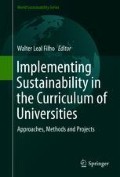Abstract
Since 2015, governments, businesses and civil society, together with the United Nations have been encouraged to work towards seventeen Sustainable Development Goals (SDGs) as part of the 2030 Agenda for Sustainable Development (United Nations, 2017). In this context, Higher Education Institutions (HEIs) have a special responsibility to embrace the SDGs as they educate the decision-maker of tomorrow. The aim of this paper is to give practical examples of how to embed the SDGs in the curriculum of an HEI by outlining the process of integrating the SDGs into the core curriculum at Nottingham Trent University (NTU). This includes, among others; a Future Thinking Learning Room: an innovative online resource library, discipline specific approaches, the use of the estate as a ‘Living Lab’, community case studies and investing in staff development. As a result, ESD no longer needs to be an afterthought when it comes to curriculum content, allowing it to be an easily achievable priority across all academic departments. This chapter may be of interest to those looking for inspiration and ways to embed the SDGs within Higher Education and beyond.
Green Academy: Nottingham Trent University, 50 Shakespeare St., Nottingham NG1 4FQ, email: GreenAcademy@ntu.ac.uk.
Notes
- 1.
The People and Planet University League is an independent league table of UK universities. It is compiled by People and Planet, a UK-based student campaigning network that ranks universities based on a selection of criteria focusing on environmental and ethical performance.
- 2.
The Learning in Future Environments (LiFE) index is a self-assessment tool developed for Higher Education Institutions by the Environmental Association for Universities and Colleges (EAUC) that gives HEIs an opportunity to evaluate their environmental performance and social responsibility.
- 3.
The Environmental Association for Universities and Colleges (EAUC) supports HEIs in the UK with environmental management and sustainability work through a range of initiatives, including the Green Gowns Award and the LiFE index.
- 4.
The Responsible Futures accreditation was created by the National Union of Students (NUS), to assess how well HEIs are embedding sustainability and social responsibility in the formal and informal curriculum.
References
Beichner RJ, Saul M, Abbott D, Morse JJ, Deardorff DL, Allain RJ, Bonham SW, Dancy MH, Risley JS (2007) The student-centered activities for large enrollment undergraduate programs (SCALEUP) project. Research-Based Reform of University Physics. [Online]. Available at http://www.compadre.org/per/items/detail.cfm?ID=4517. Accessed 14 Feb 2017
British Council (2014) UK Alumni Leading the World. Available https://www.britishcouncil.org/organisation/press/uk-alumni-leading-world. Accessed 17 Jan 2017
Leal Filho W, Manolas E, Pace P (2015) The future we want: key issues on sustainable development in higher education after Rio and the UN decade of education for sustainable development. Int J Sustain. High Educ 16(1):112–129
Lipscombe B, Burek C, Potter J, Ribchester C, Degg M (2008) An overview of extra-curricular education for sustainable development (ESD) interventions in UK universities. Int J Sustain High Educ 9(3):222–234
Molthan-Hill P (ed) (2017) The business student’s guide to sustainable management: principles and practice, 2nd edn. Greenleaf/PRME book series. Greenleaf, Sheffield
Molthan-Hill P, Dharmasasmita A, Winfield F (2015) Academic freedom, bureaucracy and procedures: the challenge of curriculum development for sustainability. In Leal Filho W, Davim JP (eds) Challenges in higher education for sustainability. Springer, Cham, Switzerland, pp 199–215. ISBN:978-3-319-23705-3
Newman-Storen R (2014) Leadership in sustainability: creating an interface between creativity and leadership theory in dealing with “Wicked Problems”. Sustainability 6:5955–5967
Nottingham Trent University (2015) Creating the university of the future. Available https://www4.ntu.ac.uk/strategy/. Accessed 17 Jan 2017
Puntha H, Molthan-Hill P, Dharmasasmita A, Simmons E (2015) Food for thought: a university-wide approach to stimulate curricular and extracurricular ESD activity. In: Integrating sustainability thinking in science and engineering curricula. Springer, Berlin, pp 31–47
Sachs JD (2012) From millennium development goals to sustainable development goals. Lancet 2012(379):2206–2211. doi:10.1016/S0140-6736(12)60685-0
Simmons EA, McNeil J, Lamb S (2016) Curriculum Refresh: a whole-institution approach to reviewing the curriculum. Trent Institute for Learning & Teaching. Nottingham Trent University, Nottingham
Tierney A, Tweddell H, Willmore C (2015) Measuring education for sustainable development: experiences from the University of Bristol. Int J Sustain High Educ 16(4):507–522
Tilbury D (2015) Higher education for sustainability. Routledge Handbook of Higher Education for Sustainable Development
UNESCO (2017) Education for sustainable development. http://en.unesco.org/themes/education-sustainable-development. Accessed 27 Jan 2017
United Nations Sustainable Development Knowledge Platform (2017) Transforming our world: the 2030 Agenda for Sustainable Development. https://sustainabledevelopment.un.org/post2015/transformingourworld. Accessed 27 Jan 2017
Wals AE (2014) Sustainability in higher education in the context of the UN DESD: a review of learning and institutionalization processes. J Clean Prod 62:8–15
Author information
Authors and Affiliations
Corresponding author
Editor information
Editors and Affiliations
Rights and permissions
Copyright information
© 2018 Springer International Publishing AG
About this chapter
Cite this chapter
Willats, J., Erlandsson, L., Molthan-Hill, P., Dharmasasmita, A., Simmons, E. (2018). A University Wide Approach to Embedding the Sustainable Development Goals in the Curriculum—A Case Study from the Nottingham Trent University’s Green Academy. In: Leal Filho, W. (eds) Implementing Sustainability in the Curriculum of Universities. World Sustainability Series. Springer, Cham. https://doi.org/10.1007/978-3-319-70281-0_5
Download citation
DOI: https://doi.org/10.1007/978-3-319-70281-0_5
Published:
Publisher Name: Springer, Cham
Print ISBN: 978-3-319-70280-3
Online ISBN: 978-3-319-70281-0
eBook Packages: Earth and Environmental ScienceEarth and Environmental Science (R0)

